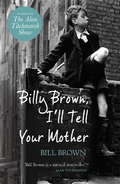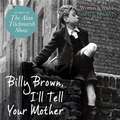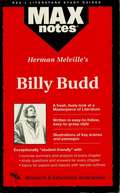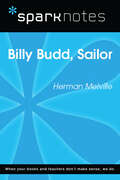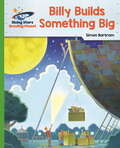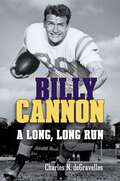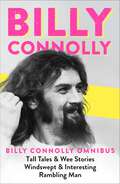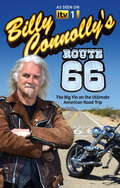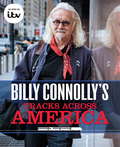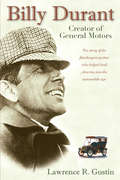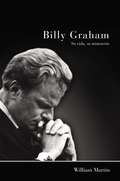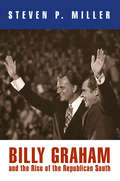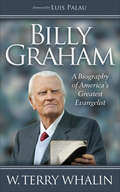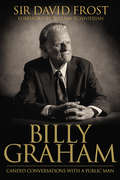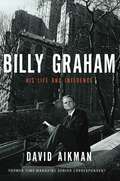- Table View
- List View
Billy Brown, I'll Tell Your Mother
by Bill BrownA riveting and hugely entertaining memoir of post-war London told through the eyes of a hilariously opportunistic little boy.By the time he was ten years old, Billy Brown was running a successful little business on the black market: whatever you needed, from bricks and firewood to dress material or machetes, Billy Brown could get it - or knew a man who could. And, for the right price, he would deliver it direct to your door in an old carriage pram.With energy and insight, Billy Brown paints a vivid and lively picture of Britain emerging from the ruins of the war, the hunger for opportunity, the growing pace of modernisation and the pride and optimism that held communities together. Londoners were intent on getting themselves back on their feet, and it provided the perfect opportunity for a boy with ambition and a lively imagination.Born in Brixton, south London, in 1942, Billy Brown was a lovable scamp with a nose for mischief. Left to his own devices while both his parents went out to work, if there was trouble to be had Billy would be in the thick of it. Ignoring the shaking of fists from his neighbours, his mother's scoldings and the regular thwack of the cane on his bottom at school, Billy wheeled and dealed, charmed Woolies' Girls, planned coronation celebrations, ran circles around circus performers and persuaded villains to work on his terms.
Billy Brown, I'll Tell Your Mother
by Bill BrownBy the time he was ten years old, Billy Brown was running a successful little business on the black market: whatever you needed, from bricks and firewood to dress material or machetes, Billy Brown could get it - or knew a man who could. And, for the right price, he would deliver it direct to your door in an old carriage pram.With energy and insight, Billy Brown paints a vivid and lively picture of Britain emerging from the ruins of the war, the hunger for opportunity, the growing pace of modernisation and the pride and optimism that held communities together. Londoners were intent on getting themselves back on their feet, and it provided the perfect opportunity for a boy with ambition and a lively imagination.Born in Brixton, south London, in 1942, Billy Brown was a lovable scamp with a nose for mischief. Left to his own devices while both his parents went out to work, if there was trouble to be had Billy would be in the thick of it. Ignoring the shaking of fists from his neighbours, his mother's scoldings and the regular thwack of the cane on his bottom at school, Billy wheeled and dealed, charmed Woolies' Girls, planned coronation celebrations, ran circles around circus performers and persuaded villains to work on his terms.Read by Bill Brown(p) 2011 Orion Publishing Group
Billy Budd (MAXNotes Literature Guides)
by Miriam MinkowitzREA's MAXnotes for Herman Melville's Billy Budd MAXnotes offer a fresh look at masterpieces of literature, presented in a lively and interesting fashion. Written by literary experts who currently teach the subject, MAXnotes will enhance your understanding and enjoyment of the work. MAXnotes are designed to stimulate independent thought about the literary work by raising various issues and thought-provoking ideas and questions. MAXnotes cover the essentials of what one should know about each work, including an overall summary, character lists, an explanation and discussion of the plot, the work's historical context, illustrations to convey the mood of the work, and a biography of the author. Each chapter is individually summarized and analyzed, and has study questions and answers.
Billy Budd (SparkNotes Literature Guide Series)
by SparkNotesBilly Budd (SparkNotes Literature Guide) by Herman Melville Making the reading experience fun! Created by Harvard students for students everywhere, SparkNotes is a new breed of study guide: smarter, better, faster.Geared to what today's students need to know, SparkNotes provides:chapter-by-chapter analysis explanations of key themes, motifs, and symbols a review quiz and essay topics Lively and accessible, these guides are perfect for late-night studying and writing papers.
Billy Cannon: A Long, Long Run
by Charles N. DeGravellesBilly Cannon’s name, his image, and his remarkable athletic career serve as emblems for Louisiana State University, the Southeastern Conference, and college football. LSU’s only Heisman Trophy winner, Cannon led the Tigers to a national championship in 1958, igniting a love of the game in Louisiana and establishing a tradition of greatness at LSU.But like many stories of lionized athletes who rise to the status of legend, there was a fall—and in the case of Billy Cannon, also redemption. For the first time, Charles N. deGravelles reveals in full the thrilling highs and unexpected lows of Cannon’s life, in Billy Cannon: A Long, Long Run.Through conversations with Cannon, deGravelles follows the athlete-turned-reformer from his boyhood in a working-class Baton Rouge neighborhood to his sudden rush of fame as the leading high school running back in the country. Personal and previously unpublished stories about Cannon’s glory days at LSU and his stellar but controversial career in the pros, as well as details of his indictment for counterfeiting and his post-release work as staff dentist at Louisiana State Penitentiary at Angola, unfold in a riveting biography characterized by uncanny success, deep internal struggles, and a champion’s spirit that pushed through it all.
Billy Connolly Omnibus: Tall Tales and Wee Stories/Windswept & Interesting/Rambling Man
by Billy ConnollyTHREE TIMES THE LAUGHS: THE BEST OF BILLY CONNOLLY! 'Our greatest living comedian' Daily Mail'One of stand-up's great naturals. No one told a story better.' Guardian 'Furious, funny and foul mouthed' Sunday TimesTall Tales & Wee StoriesA collection of the very best of Billy's most famous routines including The Last Supper, Jojoba Shampoo, Incontinence Pants and Shouting at Wildebeest. With an introduction and original illustrations by Billy throughout, it is an inspirational, energetic and riotously funny read, and a fitting celebration of our greatest ever comedian.Windswept & Interesting 'It's the first time I've done this. Other people have written about me - or for me - but this time it's just my own life in my own words'Billy's joyfully funny, frank and full autobiography - stuffed full of hard-earned wisdom as well as countless digressions on fishing, farting and the joys of dancing naked. It is an unforgettable, life-affirming story of a true comedy legend.Rambling ManBilly's unconventional travel memoir that criss-crosses the world, encapsulating a lifetime of incredible journeys and hundreds of fascinating encounters - from riding his trike down America's famous Route 66, building an igloo on an iceberg in the Arctic, playing elephant polo (badly) in Nepal and crashing his motorbike (more than once), to eating witchetty grubs in Australia, being serenaded by a penguin in New Zealand, and swapping secrets in a traditional Sweat Lodge ritual in Canada.
Billy Connolly Omnibus: Tall Tales and Wee Stories/Windswept & Interesting/Rambling Man
by Billy ConnollyTHREE TIMES THE LAUGHS: THE BEST OF BILLY CONNOLLY! 'Our greatest living comedian' Daily Mail'One of stand-up's great naturals. No one told a story better.' Guardian 'Furious, funny and foul mouthed' Sunday TimesTall Tales & Wee StoriesA collection of the very best of Billy's most famous routines including The Last Supper, Jojoba Shampoo, Incontinence Pants and Shouting at Wildebeest. With an introduction and original illustrations by Billy throughout, it is an inspirational, energetic and riotously funny read, and a fitting celebration of our greatest ever comedian.Windswept & Interesting 'It's the first time I've done this. Other people have written about me - or for me - but this time it's just my own life in my own words'Billy's joyfully funny, frank and full autobiography - stuffed full of hard-earned wisdom as well as countless digressions on fishing, farting and the joys of dancing naked. It is an unforgettable, life-affirming story of a true comedy legend.Rambling ManBilly's unconventional travel memoir that criss-crosses the world, encapsulating a lifetime of incredible journeys and hundreds of fascinating encounters - from riding his trike down America's famous Route 66, building an igloo on an iceberg in the Arctic, playing elephant polo (badly) in Nepal and crashing his motorbike (more than once), to eating witchetty grubs in Australia, being serenaded by a penguin in New Zealand, and swapping secrets in a traditional Sweat Lodge ritual in Canada.
Billy Connolly's Route 66: The Big Yin on the Ultimate American Road Trip
by Billy ConnollyBritain's best-loved comedian hits the most famous highway in the world on an unforgettable journey.Billy Connolly, music-lover, biker, and scourge of the beige and bland the world over, has dreamed about taking a trip on the legendary Route 66 since he heard Chuck Berry belting out one of the greatest rock 'n' roll records of all time. And now he's finally had the chance to do it, travelling every mile on his custom-made trike in search of the real America that can still be found beyond the nation's freeways.Taking in both the essential icons and the hidden gems of the 'Mother Road', Billy also meets up with plenty of the memorable characters who call it home. With his instinct for a good story, and the infectious enthusiasm that has made him our most engaging national treasures, Billy Connolly is the ultimate guide to the ultimate road trip.
Billy Connolly's Route 66: The Big Yin on the Ultimate American Road Trip
by Billy ConnollyBritain's best-loved comedian hits the most famous highway in the world on an unforgettable journey.Billy Connolly, music-lover, biker, and scourge of the beige and bland the world over, has dreamed about taking a trip on the legendary Route 66 since he heard Chuck Berry belting out one of the greatest rock 'n' roll records of all time. And now he's finally had the chance to do it, travelling every mile on his custom-made trike in search of the real America that can still be found beyond the nation's freeways.Taking in both the essential icons and the hidden gems of the 'Mother Road', Billy also meets up with plenty of the memorable characters who call it home. With his instinct for a good story, and the infectious enthusiasm that has made him our most engaging national treasures, Billy Connolly is the ultimate guide to the ultimate road trip.
Billy Connolly's Route 66: The Big Yin on the Ultimate American Road Trip
by Billy ConnollyFollow much-loved Scottish comedian and bestselling author Billy Connolly across Route 66, on this unforgettable journey filled with music, modern history and hilarious stories.Billy Connolly first dreamed of taking a trip on the legendary Route 66 when he heard Chuck Berry belting out one of the greatest rock 'n' roll records of all time - and now he's finally had the chance to do it. Travelling every one of its 2,278 miles on his custom-make motorbike, Billy's journey takes him past many of the best-known icons in the US: the Gateway Arch in St Louis, Monument Valley and the Grand Canyon, and the funky neon-lit gas stations and diners that once lined the route.Billy also has the chance to get to know the people who call it home, from Mervin the Amish carpenter, to fellow banjo enthusiast and obsessive instrument collector Rob, to Angel, one of the many people determined to keep the spirit of the Mother Road alive. Funny, touching and inspiring in equal measure, the tales he gathers on the way tell the story of modern America.With his unrivalled instinct for a good story, and the gregariousness that has made him a comedy legend, Billy Connolly is the ultimate guide to the ultimate road trip.
Billy Connolly's Tracks Across America
by Billy ConnollyAn epic trip across America with much-loved national treasure and comedy legend, Billy ConnollyBilly Connolly has spent much of his life in the United States, where he now lives. It's a country he knows and loves a great deal, but even someone as well-travelled as Billy can always discover new things about such a vast nation. So he's off on the move again, this time via the tracks of the great railroads that helped to build the country.Billy's adventure takes him on an incredible trip through the backyard of America, tracing the routes taken by the first European settlers westwards from Chicago to California, then back down south and eastwards through Arizona, Texas, Alabama and finally New York, over 6,000 miles and 26 states later.It's a journey through a country you don't get to see from 30,000 feet in the air - the real America of friendly people with fascinating tales to tell which not only give us an insight into their lives, but also into the life of their great homeland. And it's a journey that couldn't be shared with a more entertaining companion.Hop aboard and join Billy on a trip you'll never forget.Update: Type size issue in ebook now fixed.
Billy Connolly's Tracks Across America
by Billy ConnollyBilly Connolly - raconteur, comedian, and irrepressible wanderer - has spent much of his life in the United States. It's a country he knows and loves a great deal, but even someone as well-travelled as Billy can always discover knew things about such a vast nation. So he's off on the move again, this time via the tracks of the great railroads that helped to build the country.Billy's latest adventure takes him on an epic trip through the backyard of America, tracing the routes taken by the first European settlers westwards from Chicago to California, then back down south and eastwards through Arizona, Texas, Alabama and finally New York, over 6,000 miles and 26 states later. It's a journey through a country you don't get to see from 30,000 feet in the air - the real America of friendly people with fascinating tales to tell which not only give us an insight into their lives, but also into the life of their great homeland. And it's a journey that couldn't be shared with a more entertaining companion. Hope aboard and join Billy on a trip you'll never forget.
Billy Connolly's Tracks Across America
by Billy ConnollyAn epic trip across America with much-loved national treasure and comedy legend, Billy ConnollyBilly Connolly has spent much of his life in the United States, where he now lives. It's a country he knows and loves a great deal, but even someone as well-travelled as Billy can always discover new things about such a vast nation. So he's off on the move again, this time via the tracks of the great railroads that helped to build the country.Billy's adventure takes him on an incredible trip through the backyard of America, tracing the routes taken by the first European settlers westwards from Chicago to California, then back down south and eastwards through Arizona, Texas, Alabama and finally New York, over 6,000 miles and 26 states later.It's a journey through a country you don't get to see from 30,000 feet in the air - the real America of friendly people with fascinating tales to tell which not only give us an insight into their lives, but also into the life of their great homeland. And it's a journey that couldn't be shared with a more entertaining companion.Hop aboard and join Billy on a trip you'll never forget.
Billy Durant: Creator of General Motors
by Lawrence R. GustinWhat explains Billy Durant's powerful influence on the auto industry during its early days? And why, given Durant's impact, has he been nearly forgotten for decades? In search of answers to these questions, Lawrence Gustin interviewed Durant's widow, who provided a wealth of previously unpublished autobiographical notes, letters, and personal papers. Gustin also interviewed two of Durant's personal secretaries and others who had known and worked with the man who created General Motors. The result is the amazing account of the mastermind behind what would become, as the twentieth century progressed, the world's largest company.
Billy Graham
by Marshall FradyMarshall Frady's epic biography of the most prominent and popular religious leader in America. With unparalleled access to Billy Graham and his family and associates, Frady presents an intimate and multifaceted portrait of the man, from his childhood upbringing in the midlands of North Carolina to his ascent to national recognition. Frady's narrative encompasses the man, his spiritual mission, and his political involvements and bears witness to the preeminent position Graham has held in American life for more than five decades. This remains the most compelling and definitive biography of him to date.
Billy Graham - Su vida, su ministerio
by William C. MartinEste libro celebra a una de las grandes luminarias del siglo veinte. Este libro cautivador y comprehensivo da a los lectores religiosos o seculares una mejor comprensión del evangelista más exitoso de la historia moderna, y del movimiento que él dirigió por más de cincuenta años.El libro hace una contribución vital al legado de Billy Graham y nos permite entender por qué sus palabras, acciones y personalidad le ganaron el aprecio de papas y predicadores, reyes y presidentes, y millones de cristianos virtualmente en toda nación y cultura por todo el mundo, por más de medio siglo.Esta biografía Graham mismo pidió y apreció por su enfoque proporcionado pero franco. En este relato cuidadosamente documentado, eminentemente equitativo, y bien escrito, William Martin plantea y contesta preguntas clave en cuanto al carácter, contribuciones e influencia de Graham a la escena religiosa del mundo. Siguiendo la vida y ministerio de Graham, desde sus raíces rurales y religiosas en Carolina del Norte, a su lugar como el estadista más veterano del evangelicalismo estadounidense, siguiendo tanto sus triunfos como sus tribulaciones, Martin muestra el carácter multidimensional del hombre que ha llegado a ser una de las personas más admiradas del mundo. Este cautivador y comprehensivo libro ofrece una comprensión detallada del evangelista más exitoso de la historia moderna, y del movimiento que él dirigió por más de cincuenta años.
Billy Graham and Seven Who Were Saved
by Lewis W. GillensonOne of the greatest preachers of all time, Billy Graham has penetrated the conscience of people throughout the world. Untold thousands have experienced dramatic spiritual changes as a result of Graham's evangelism. In this fascinating book, the stirring events in the conversions of seven remarkable people are movingly told. This is the wonderfully human story of their weaknesses and fears, and their agonizing struggles to overcome them. It is also the amazing account of the effects of Graham's inspiring ministry. Through him, these defeated souls were able to change their lives in a profoundly meaningful way. Some came to know happiness for the first time. The Seven Who Were Saved Jimmy Karam-- A tough politician who acknowledged his sins, but couldn't overcome them... Eleanor Searle Whitney-- A beautiful socialite who nearly gave up hope when her marriage ended in divorce... Jim Vaus-- An engineer who sold his wire-tapping services to both sides of the law... Johnny Spence-- A golf pro who traded sports for dope... Jean Dillard-- A painter who lost faith in God and herself... Stuart Hamblen-- A cowboy-singer who drowned his fortune in alcohol... Henderson Belk-- A spoiled boy whose self-indulgence almost ruined his family.
Billy Graham and the Rise of the Republican South
by Steven P. MillerWhile spreading the gospel around the world through his signature crusades, internationally renowned evangelist Billy Graham maintained a visible and controversial presence in his native South, a region that underwent substantial political and economic change in the latter half of the twentieth century. In this period Graham was alternately a desegregating crusader in Alabama, Sunbelt booster in Atlanta, regional apologist in the national press, and southern strategist in the Nixon administration.Billy Graham and the Rise of the Republican South considers the critical but underappreciated role of the noted evangelist in the creation of the modern American South. The region experienced two significant related shifts away from its status as what observers and critics called the "Solid South": the end of legalized Jim Crow and the end of Democratic Party dominance. Author Steven P. Miller treats Graham as a serious actor and a powerful symbol in this transition--an evangelist first and foremost, but also a profoundly political figure. In his roles as the nation's most visible evangelist, adviser to political leaders, and a regional spokesperson, Graham influenced many of the developments that drove celebrants and detractors alike to place the South at the vanguard of political, religious, and cultural trends. He forged a path on which white southern moderates could retreat from Jim Crow, while his evangelical critique of white supremacy portended the emergence of "color blind" rhetoric within mainstream conservatism. Through his involvement in the Eisenhower and Nixon administrations, as well as his deep social ties in the South, the evangelist influenced the decades-long process of political realignment.Graham's public life sheds new light on recent southern history in all of its ambiguities, and his social and political ethics complicate conventional understandings of evangelical Christianity in postwar America. Miller's book seeks to reintroduce a familiar figure to the narrative of southern history and, in the process, examine the political and social transitions constitutive of the modern South.
Billy Graham in Quotes
by Franklin GrahamGod Speaks His Word Straight Into The Hearts Of Men And Women.The Word Of God Is Alive And Active Today In The Lives Of Millions.With the Gospel of the Lord Jesus Christ as his singular focus, Billy Graham has faithfully, passionately, and unapologetically preached God's Word for more than seventy years. At the age of ninety-two, during an exclusive Fox News interview in 2010, Dr. Graham told Greta van Susteren, "I have a tremendous amount of hope for the future because of Jesus Christ."In this stunning collection of quotes by Billy Graham comes a historic anthology covering seven decades of ministry, drawing from both his published and personal works. These pages are filled with hope, truth, and redemption and seek the hearts of a lost people who need God now more than ever.Today we are putting our hopes in materialism, in technological progress, and in freedom from moral absolutes. They have all failed. They have failed because they have been powerless to change the human heart.Join Billy Graham as he seeks to bring God's Word to the heart of daily life. Reconnect and be drawn like never before. "Hearing Billy Graham express hope for the world gives me hope that my life can be worthwhile," comments one twenty-two-year-old. Arranged topically for easy reference, Billy Graham in Quotes provides insight on more than one hundred topics anchored in Scripture. This gifted evangelist takes the focus off of the messenger and shines the Light on the Message of God's Word.Earth's troubles fade in the light of heaven's hope.
Billy Graham: A Biography of America's Greatest Evangelist
by W. Terry Whalin&“Our polarized, divided world dearly misses the spirit of grace that Billy Graham brought to the world . . . A biography that introduces him anew&” (Philip Yancey, bestselling author of What&’s So Amazing About Grace?). Billy Graham has preached the gospel message in person to more people than anyone in history, and millions more have heard him through television, radio, and film. His faithful witness is testimony to his great love of God and passion to serve Him. This easy-to-read biography tells Billy Graham&’s story, including his humble beginnings as a southern farm boy, his calling to the ministry, the start of the crusades, his service to America&’s leaders, and his later years preaching around the globe. As you read these details of a life dedicated to the cause of Christ, you will be encouraged. Also, these stories will inspire anyone who desires to give their life in service to God. Here&’s a fresh look at a contemporary man of God and giant of the faith. &“Well written and succinct, Billy Graham is an honest look at the man and his calling, his struggles to stay humble in the limelight, the difficulty of separation from his family, and his constant calling on God for the next step.&” —Deborah Bedford, New York Times–bestselling author of His Other Wife &“If you want to cultivate a passion for souls, get to know Mr. Graham in the pages of this book. I promise you&’ll be blessed!&” —Joni Eareckson Tada, Joni and Friends International Disability Center
Billy Graham: A Tribute from Friends
by Vernon McLellanBilly Graham's legacy is celebrated in a collection of poignant tributes and memories as leaders from the worlds of government, business, sports, entertainment and religion share their personal stories and remembrances of this remarkable man.
Billy Graham: Candid Conversations with a Public Man
by David FrostMost people know Billy Graham the preacher.Many know Billy Graham the author.In this remarkable book, Graham reveals a personal side that few have seen before. For thirty years, Billy Graham and David Frost fascinated television audiences with their conversations about God, the Bible, and Graham's decades-long ministry. Frost asked the questions that thousands of viewers wanted to ask. Graham answered them with authenticity and grace. Along the way, Graham provided insight into life as an evangelist, a Christian father and grandfather, and a public figure in a changing culture. Most of all, Graham's words show what it means to live out your beliefs--whether you speak to millions of people around the world or simply want to live faithfully at home and work. With a chronology of Graham's life, a preface from Frost, and a foreword from his grandson, Tullian Tchividjian, this weaving of stories, interviews, and reflections will inspire you to respond to God's call with no reserve.
Billy Graham: His Life and Influence
by David AikmanIF THERE WERE SUCH A JOB AS THE NATION&’S PASTOR, IT WOULD GO TO BILLY GRAHAMGraham wasn&’t born with a mandate to become the face of modern evangelism. Growing up, he wasn&’t much different from other boys in his town. Billy was more interested in going to the movies than the moving of the Holy Spirit, and he spent more time chasing girls than God. But at a revival meeting the day before his sixteenth birthday, Graham committed himself to Christ and never looked back. That day, he started on the path that would make him the most influential Christian leader in American history. In Billy Graham: His Life and Influence, acclaimed author David Aikman probes critical episodes of Graham&’s life that help explain his profound impact, both on the public life of America and other nations and the private lives of their cultural and political leaders. From the racial upheaval of the civil rights movement to the social turmoil of the cold war, Aikman traces Graham&’s profound influence on a nation as it went through wrenching changes over the span of more than a half century. Through vivid anecdotes and fascinating details, Billy Graham: His Life and Influence tells the story of how a country boy from Charlotte with a heart for God grew up to help shape the world.
Billy Graham: Just Get Up Out of Your Seat
by Catherine MackenzieBilly was born on a dairy farm in Charlotte, North Carolina in 1918 just days after the signing of the armistice that ended the first world world war. At the age of sixteen Billy Graham came to Christ during a Christian revival meeting and it wasn't long before he felt the call to preach. <p><p> With the help of his wife Ruth and many other friends and colleagues Billy Graham set out to preach to the world. The Billy Graham Evangelistic Association was founded and since that day Billy has preached to over 80 million people in more than 185 countries. Millions more have been reached through television, video, film and webcasts. He has founded newspapers; film companies, magazines and radio ministries. Communism and Apartheid, Segregation and Terrorism - Billy Graham has faced up to all Christianity's major opponents of the twentieth century. <p> From playing the bail money to get Martin Luther King out of jail to addressing the memorial service in Washington after the collapse of the World Trade centre, Billy Graham has been there for people with practical help and a message of hope that is timeless.
